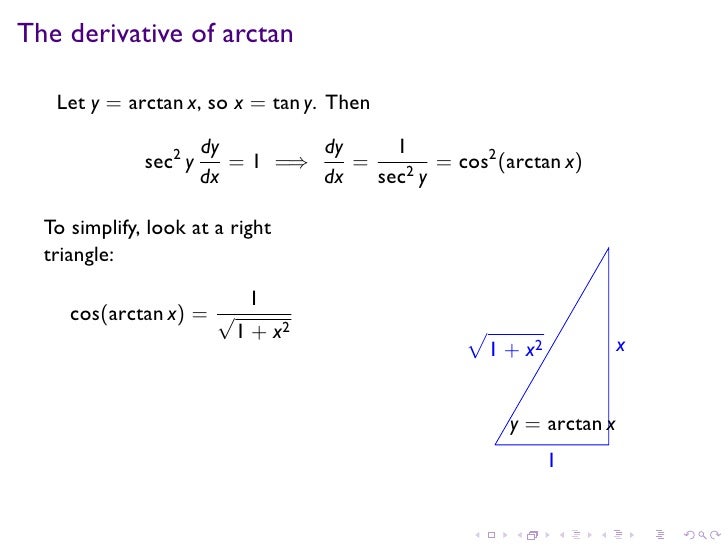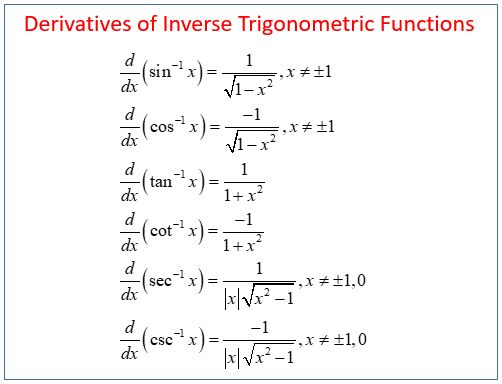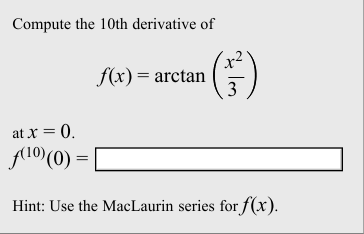Find the first derivative of f(x) = arctan x + x 2 Solution to Example 2: Let g(x) = arctan x and h(x) = x 2, function f may be considered as the sum of functions g and h: f(x) = g(x) + h(x). Hence we use the sum rule, f '(x) = g '(x) + h '(x), to differentiate function f as follows f '(x) = 1 / (1 + x 2 ) + 2x = (2x 3 + 2x + 1) / (1 + x 2 ).
DERIVATIVES OF INVERSE TRIGONOMETRIC FUNCTIONS
- Assuming we know the derivative of tan(x) is sec 2 (x): Let y = arctan(x) so that x = tan(y). Differentiate both sides with respect to x to get: 1 = sec 2 (y) dy/dx. Now use the identity. Sin 2 (y) + cos 2 (y) = 1. Divide by cos 2 (y) to get. Tan 2 (y) + 1 = sec 2 (y) Use the substitution tan(y) = x to get. Sec 2 (y) = 1 + x 2.
- Free derivative calculator - differentiate functions with all the steps. Type in any function derivative to get the solution, steps and graph.
Differentiation of inverse trigonometric functions is a small and specialized topic. However, these particular derivatives are interesting to us for two reasons. First, computation of these derivatives provides a good workout in the use of the chain rule, the definition of inverse functions, and some basic trigonometry. Second, it turns out that the derivatives of the inverse trigonometric functions are actually algebraic functions!! This is an unexpected and interesting connection between two seemingly very different classes of functions.
It is possible to form inverse functions for restricted versions of all six basic trigonometric functions. One can construct and use an inverse cosecant function, for example. However, it is generally enought to consider the inverse sine and the inverse tangent functions. We will restrict our attention to these two functions.
Here are the results.
|
|
In order to verify the differentiation formula for the arcsine function, let us set
y = arcsin(x).We want to compute dy/dx. The first step is to use the fact that the arcsine function is the inverse of the sine function. Among other things, this means that
sin(y) = sin(arcsin(x)) = x.Next, differentiate both ends of this formula. We apply the chain rule to the left end, remembering that the derivative of the sine function is the cosine function and that y is a differentiable function of x.
| = |
| ||||||||
| = | 1 |
The next step is to solve for dy/dx. (After all, this is the thing that we want to compute!)
| = |
| = | sec(y) |
This looks like progress, but it is not the answer. Remember, when we differentiate a function of x in terms of x (this is the meaning of the dx in d/dx), we must express our answer in terms of x. Therefore the question remains.
If sin(y)=x, what is cos(y) in terms of x?
The length of the third side of the reference triangle is determined by the Pythagorean Theorem.
12=x2+The last step is to express the trigonometric functions of y in terms of ratios of side lengths in the reference triangle. In particular, the secant of y is equal to the hypotenuse length divided by the adjacent side length.(third side)2 (third side)2 = 1-x2third side =sqrt(1-x2)
| = |
| = | sec(y) | = |
|
Derivative Of Arctan 1
This completes our study of differentiation for now. In Stage 6, we will investigate another general differentiation technique called implicit differentiation. Later still, we will learn how to differentiate exponential and logarithmic functions. For now, you should go to the Practice area and spend some time learning to use the many differentiation techniques that have been introduced in this Lesson. If there is one skill that we must develop for success in differential calculus, it is differentiation!! Enjoy, and good luck!!
If you find that you are having difficulty with differentiation, don't worry. You're not the first person to struggle with this technical skill. Contact your classmates. Discuss your difficulties. Contact your instructor. We can learn to do this!!
We now turn to the exponential and logarithmic functions. We have already discussed 'the' exponential function: exp(x)=ex. In order to differentiate the 'other' exponential functions and the logarithmic functions, we must first compute the derivative of the inverse to the exponential function. Thus we turn our attention to the natural logarithm.


| COVER | CQ DIRECTORY | HUB | CQ RESOURCES |

© CalculusQuestTM
Version 1
All rights reserved---1996
William A. Bogley
Robby Robson
What is the derivative of #y=arctan(cos(x))#?
1 Answer
This is a case of knowing the how the derivative of inverse tangent works, and then following the chain rule.
If we were looking at
First remember that
So
Notice the tangent is no longer an inverse after the switch.
Now we can use implicit differentiation. That's where we don't care whether or not we're looking at a function, that is, we don't care if we have y on one side and everything else on the other. We just derive everything as we go along, and we write

So we derive
and we get
which is the same as
Which seems straightforward enough. Except for one thing. We don't usually have derivatives that still have y's in them. Not in the first year of Calculus, anyway. We should get rid of that y.
We can go back to a right triangle here. We started with
So:
Then by the Pythagorean Theorem, the hypotenuse can be found:
So the
meaning that if
then
which is the same as
So if we're looking at
Derivative Of Arctan(3x)
The chain rule say that if you have an 'inside function' and an 'outside function,' then you take the derivative of the outside function, and multiply that by the derivative of the inside function, or
If
Notice the inside function does not change when you derive the outside function.
If
Finally:
since the derivative of
Written more simply,
Hope this helps.
Related topic
Questions